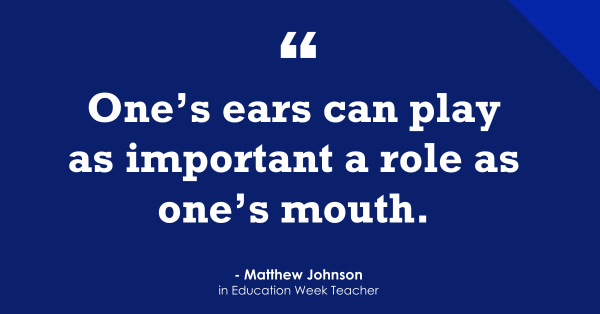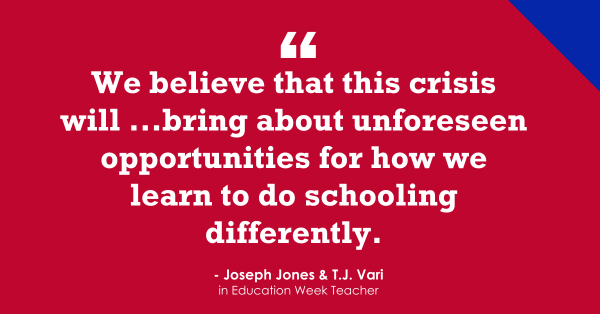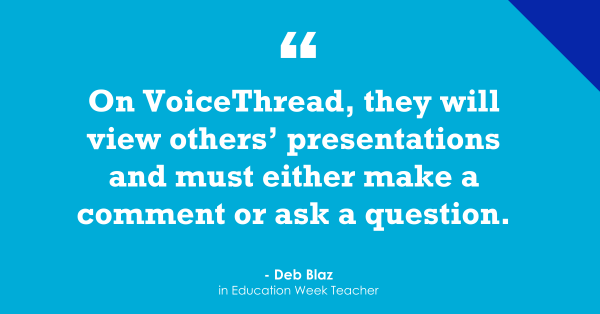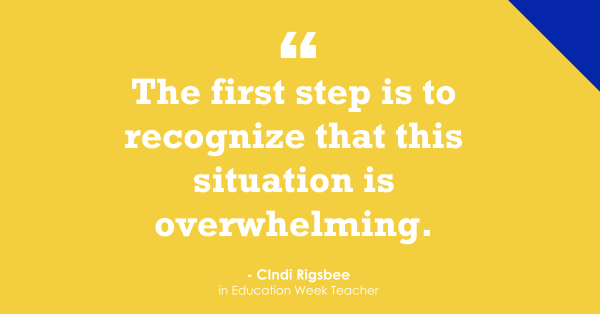Matthew: Ways Educators Are Responding to School Closures
date:2020-03-23 10:56author:小编source:EdWeekviews:
The new question of the week is:
How can we best support students when we teach online?
In Part One, David Sherrin, Lorie Barber, Janelle Henderson, and Cathleen Beachboard contributed their experiences.
In Part Two, Amy Roediger, Dr. PJ Caposey, Michael Silverstone, and Jeremy Hyler shared their reflections.
Today, Matthew Johnson, Joseph Jones, T.J. Vari, Deb Blaz, and Cindi Rigsbee offer their ideas.
Listening instead of talking
Matthew Johnson is an English teacher from Ann Arbor, Mich., and the author of the Corwin Literacy book Flash Feedback: Responding to Student Writing Better and Faster - Without Burning Out. Matt blogs at www.matthewmjohnson.com:
Like a great many of the teachers in this country, I woke up on Monday of last week thinking about the usual things—my lesson plans, papers to respond to, and the pieces I was working on—and yet by Friday, my school was shuttered along with every other school in my state for a minimum of three weeks, likely longer.
My first instinct was that I needed to start assembling online-learning tools to help my students and find ways to offer them support and guidance. But I was struck by a sudden realization: I had no idea what my students needed in this moment. After a decade and a half in the classroom, I have schema for most things education-related, but with this, I have no playbook.
I realized that instead of guessing at what my students were thinking, feeling, and needing, I had to ask them. So my first assignment last Monday was asking students to write a letter to me about how they were doing, what they were worried and sad about, what they have been doing to occupy themselves, what non-COVID-19 things are happening in their lives right now, what they are most eager to learn by the end of the year, and how much work they feel is manageable. A link to the full prompt is here.
The results were incredible! And their words helped me a great deal as both their teacher setting up a new classroom structure and in my own journey through this new world. So many students also were deeply thankful that an adult in this crisis was asking about their thoughts, worries, and needs instead of just giving them advice. Many offered suggestions that have helped me establish better supports and systems.
As teachers, our words are life-changing every day, and in the upcoming months, they will play a huge part in helping our students through this time, but it is worth remembering that in times of stress and upheaval, one's ears can play as important a role as one's mouth.

Social distancing, school closures, and learning from home
Joseph Jones is the superintendent of New Castle County Vo-Tech, and T.J. Vari is the assistant superintendent of secondary schools and operations in Appoquinimink, two Delaware school systems. They are also the authors of Candid and Compassionate Feedback and co-authors of Passionate Leadership and Building a Winning Team. Their blogs and podcasts can be found at theschoolhouse302.com:
COVID-19 hijacked the educational system, likely changing how we think about schooling for young people into the far future. In one moment, we were discussing flight arrangements to ASCD's Empower20 conference, and the next moment, we were preparing communication to families about schools being closed for two weeks. The rapid spread of the virus, and the serious nature of its health concerns, results in nothing less than a scramble to figure out everything from meal programs to offering instruction online. Schools around the country are working around the clock to respond to this ever-changing scenario.
One of the biggest hurdles is how to provide instruction at home. While some states have policies that govern online learning, many do not. While some districts have strong one-to-one device deployment for home usage, many do not. And while some communities have widely accessible internet, too many households do not. These reasons, and a host of others, make the closing of schools a very complicated situation, especially as districts around the country go beyond a short period of closure for deep cleaning.
Nonetheless, schools have begun to tackle the issues with online learning, including what a successful cyberschool might provide. But online learning is not just about access and availability. Online options can be viable for lesson delivery, but engagement with content cannot be solely considered in the typical online asynchronous fashion that we mostly use to date. The current platforms we use weren't meant to be the only delivery mechanism, at least not at scale.
The online learning conversation has to be about what school looks like from home and not just how to get learning online. Of course this is also an equity issue—those who have remote access through the internet using at-home devices have the means to experience school online; others do not. The pandemic has forced us all to take a hard look at our instructional capabilities beyond the walls of a school. But that's not the only problems we're facing.
A major issue that administrators are wrestling with is the difference between access and engagement. Even if (or when) all students have access to online learning, we are faced with an engagement problem. Essentially, when teaching moves to an online platform, the concern shifts from students being able to access new information to how students are independently experiencing meaningful engagement with it that will result in learning. Many schools are equipped with their own learning-management system (LMS), but these platforms are mostly used to keep families informed, offer remediation and enrichment, and house materials associated with face-to-face courses. In the absence of a fully functioning cyberschool, many districts aren't currently equipped to provide more than a few courses in an online format. COVID-19 is suddenly forcing schools to figure out how we can engage students from a distance—something that might have otherwise taken years to do, including training teachers, developing curriculum, and building new tools.
This problem is not just about the diverse needs of our learners, either. There's a human social construct that we need to meet. Schools provide a structure for kids that inherently includes a social experience. And while some may argue that school structures need to be expanded, schools generally do a good job scheduling blocks of time to be dedicated for content delivery. Online platforms do the opposite, and for the right reasons—making remote learning more convenient—but they miss the mark for social engagement and the accountability associated with having to report at a specified time.
The bottom line, something we've argued is important for all school endeavors, is that just providing access doesn't promote the level of agency that students need to benefit from it. Now, with a sudden pivot to all learning being from home, we see three major questions that need immediate attention amid changing COVID-19 expectations.
1. How do we provide structures for learning at home that go beyond proving that everyone has access to posted materials?
2. How will students dive deeper into learning scenarios that push the boundaries of simply accessing information in a learning-management system?
3. How do we provide social interactions between teachers and students and students and peers that account for the dynamic way that students learn when they're in school?
The answer to the first question has come in the form of home-school schedules. These are looser than a typical school schedule, which includes more rigid start and stop times. But many schools are posting timetables to demonstrate when students should be doing work for which subjects while at home. This is helpful for parents who are working from home but also for students who don't have the accountability of parents telling them to get the work done (on their own schedule). There are problems with this type of home-school scheduling, but the benefits are clear—accountability that access even takes place, as well as help with the next two questions.
The answer to the second question comes into play when we begin using all of the features of our learning-management systems along with other tools, like Flipgrid, so that students are engaging with content in a dynamic way. Universities have used online platforms like Moodle and Blackboard for years, but many K-12 schools have not evolved to the sophistication that online content delivery requires for it to be effective. As we move quickly because of COVID-19, we'll see professional-development options emerge for teachers to prepare them to use these systems effectively. Not only will students be learning online, teachers will be as well.
The answer to the third question comes from additional tools, like Zoom, that include breakout groups and other strategies where students can see one another and talk together in real time. We're not talking about discussion boards but rather live talk time embedded within the lesson-delivery platform. Students, humans for that matter, need this prescribed social time, not just to support learning but also to support other developmentally critical aspects of their lives.
Note that the answer to the first question—home-school structures—supports the answer to the second and third questions—dynamic engagement and online social interactions. In the digital age of learning, and as long as we do social distancing because of COVID-19, we need solutions that go beyond access. We believe that this crisis will have great limitations for how students engage as learners in the short term, but it will also bring about unforeseen opportunities for how we learn to do schooling differently in the future and just how fast we can bring that about right now.

Helping students feel less isolated through apps
Deb Blaz is department chair, world languages at Angola High School in Angola, Ind.:
My students were saying they'd miss seeing each other until back in school, so I decided to use a couple of sites where they could easily make a video, for free, and see and comment on each other's, as assignments.
Flipgrid is a free, easy-to-use site for making videos and which is also to be found in the Google (G Suite) apps. Students can view all videos posted there and make comments easily.
For my level ones, I posted a daily question related to our unit, and they responded in the TL (target language): Where is your favorite place in town? Name an activity you did yesterday. Tell where you are and something you are NOT doing right now....on Flipgrid. I am also adding some questions such as: What video game or other game do you play during this break? What is your favorite movie, and are you watching it this week? etc. I am going to share some (like the movie one) with our pen pals in France, who also have school canceled, and ask them to respond.
For my level 2, they read some actual online school menus (screenshots from a couple weeks ago), and on Flipgrid again, told what they would eat for the week (there are choices of main dish, sides, and desserts on the menus).
VoiceThread is a collaborative, multimedia slide show that holds images, documents, and videos and allows people to navigate slides and leave comments in five ways—using voice (with a mic or telephone), text, audio file, or video (via a webcam).. A free VoiceThread account is available for anyone who is at least 13 years old and has a valid email address. It allows them to create up to five VoiceThreads, comment by microphone and text, and share the VoiceThreads via a share link.
My 3's are doing a unit on the preterite and imperfect in narrating a story and will make a VoiceThread to tell the plot of a favorite movie, with slides showing scenes from the movie. On VoiceThread, they will view others' presentations and must either make a comment or ask a question.
Both sites have web and mobile (phone) versions available for free.
Both sites also are not searchable, available, or readable to the public, which means no one who is not invited can view or participate in our projects. I like the privacy that affords.

"Get up. Walk outside. Breathe air."
Cindi Rigsbee is a national-board-certified ELA/reading teacher currently serving as a K-12 literacy coach in North Carolina. With over 30 years in education, Cindi was named the 2009 North Carolina Teacher of the Year and is the author of Finding Mrs. Warnecke: The Difference Teachers Make. A member of the Center for Teaching Quality's Collaboratory, Cindi was a contributing author to Teaching 2030: What We Must Do for Our Students and Our Public Schools, Now and in the Future. She blogs at cindirigsbee.com:
What a stressful time this is for all of us. It seems that the restrictions on our lives, as well as the headlines in the news, change hourly, and it's a lot to handle for sure. I think the most important thing for us to recognize is that we need to allow ourselves time to grieve.
I'm grieving over the missed opportunities for our students, not only learning opportunities but also the talent shows, the dances, the awards nights, and potentially the proms and graduations. Just today I heard about three teachers who were reduced to tears over the sheer emotion these days are bringing. (I was one of them.)
We need to accept that we have lost our very way of life as our day-to-day routines have been altered indefinitely. We must literally redefine ourselves as we become "virtual" teachers to homebound students whose lives have also been altered. And all the while, we need to forgive ourselves if we feel weepy and allow ourselves to work through the grief in ways that work for us personally.
In addition, we should recognize that we are going to be overwhelmed. When the announcement came that our schools would be closed, my first thought was that I was ill-equipped to plan for students who wouldn't be actually sitting in my classroom. But it wasn't long until resources came at me from everywhere: Social media included one post after another with links to distance-learning platforms, professional-development opportunities, and links to all things instructional; then en masse emails and conference calls became the norm. So what started as a question continues with so many answers it's hard to navigate them all.
The first step is to recognize that this situation is overwhelming ... then we need to take a breath and know that we can do this: one email at a time, one conference call at a time, one instructional resource at a time. Slow down. Literally—at this point, all we have is time.
Speaking of breathing, today I worked online several hours before I realized I hadn't gotten up out of my chair. That's surely not the case at a school. We walk around all day long there. So, even though I still had work to do, I got up and walked outside. I walked and walked and walked. I tried to walk through the grief and I tried to walk through the overwhelming cloud of uncertainty hanging over me. It helped.
Get up. Walk outside. Breathe air. It'll help you, too.
But you will still be sad and maybe a little scared.
Yesterday I dropped by my school building to pick up some books. I looked down the empty hallway and visualized the students who are usually there, giggling outside my door on the way to the bathroom, running in to hug me on their way to lunch. I pictured Ella, a 3rd grader who hugged me six times on the day we left; we didn't know she wouldn't be back the next day.
And if we don't return school at all this year, I will really struggle.
Because we didn't even have a chance to say goodbye.

Thanks to Matthew, Joseph, T.J., Deb, and Cindi for their contributions!
Please feel free to leave a comment with your reactions to the topic or directly to anything that has been said in this post.
Consider contributing a question to be answered in a future post. You can send one to me at lferlazzo@epe.org. When you send it in, let me know if I can use your real name if it's selected or if you'd prefer remaining anonymous and have a pseudonym in mind.
You can also contact me on Twitter at @Larryferlazzo.
Education Week has published a collection of posts from this blog, along with new material, in an e-book form. It's titled Classroom Management Q&As: Expert Strategies for Teaching.

